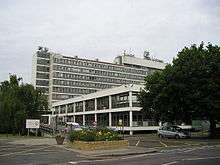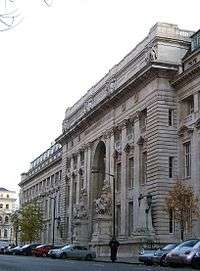Hillingdon Hospital
| Hillingdon Hospital | |
|---|---|
| The Hillingdon Hospitals NHS Foundation Trust | |
 | |
| Geography | |
| Location | Hillingdon, Greater London, England, United Kingdom |
| Organisation | |
| Care system | NHS |
| Hospital type | District General |
| Affiliated university |
Imperial College London |
| Services | |
| Emergency department | Yes Accident & Emergency |
| Beds | 409 |
| History | |
| Founded | 1744 (Hillingdon Workhouse) |
| Links | |
| Website | http://www.thh.nhs.uk |
| Lists | Hospitals in England |
Hillingdon Hospital is an NHS hospital, located in Pield Heath Road, Hillingdon, Greater London. It is a general hospital serving the local area, providing a wide variety of services including Accident and Emergency (64,000 patients annually), In-patients, Day Surgery and Outpatient Clinics. It is an incredibly busy hospital, owing possibly to the proximity of Heathrow Airport.
It is one of only two hospitals run by The Hillingdon Hospitals NHS Foundation Trust, the other being Mount Vernon Hospital.
The hospital has a PALS office based on site, the Hillingdon Consulting Rooms for private patients, and its own hospital radio station (Radio Hillingdon), staffed by volunteers.
The current chairman is Anthony Valentine, and the chief executive is David McVittie.
History
In 1744, Hillingdon Vestry decided to build a workhouse.[1] Finding a suitable site proved difficult, but it was finally decided to build it near Colham Green. The work on this was completed in 1747.
By 1830, the workhouse had grown considerably in size, and it was decided to expand it to accommodate males and females separately.
The Poor Law Amendment Act 1834 resulted in the building of the Uxbridge Union Workhouse on the site in around 1838.
Middlesex County Council took charge of the Uxbridge Union buildings in 1930 and began development into the Hillingdon Institution, an acute hospital.
Rapid progress was made and the hospital was significantly enlarged in 1932. This included replacing the wooden floors with concrete ones, the wooden ones being too weak to cope with the weight of an operating theatre table and equipment.
The hospital was damaged by bombs in October 1940, causing much damage. There were no casualties, and the hospital was moved to temporary accommodation. This proved to be unpopular, and following the war, the number of beds in the hospital declined owing to a lack of staff. The Medical Director of the time, Dr W. Arklay Steel, was concerned about the condition of the hospital. In 1948, when the NHS took charge, the hospital consisted of a series of temporary buildings in varying states of disrepair.
In 1957, it was agreed to rebuild Hillingdon Hospital. Following this, in 1960, the maternity wing of the hospital was opened and is still in operation today.
Sir Arnold France, Secretary of the Ministry of Health, opened the current Hillingdon Hospital on 10 January 1967. It had cost £3.2 million to build. It provided seven new wards, including the provision of some single rooms, outpatients department, imaging department, accident and emergency services, operating theatres and recovery suites, pathology laboratories, physiotherapy, occupational therapy and a canteen.
It was heralded as being an innovative new hospital, with a central vacuum system and piped oxygen throughout. Wards were named alphabetically, with K for Kennedy Ward being at the top of the hospital.[1]
In December 2008, Bevan Ward was opened. This ward, named in honour of the founder of the NHS, Aneurin Bevan, consists of three clusters of eight ensuite patient rooms. Each cluster is slightly different in design, allowing detailed research into patient satisfaction, sleep quality, privacy and infection rates. This has been heralded as the future of hospital care in the UK. Patients and staff alike are very pleased with the new facilities, with some describing it as being like a five-star hotel. It was visited in 2009 by Health Secretary Alan Johnson, who was apparently struck by the patient satisfaction.[2][3]
The newly refurbished Fleming Ward opened in November 2009.[4]
An eye clinic at the hospital received an award in 2010 from the Macular Disease Society for its work in Macular Degeneration.[5]
The hospital trust became an independent NHS foundation trust on 1 April 2011.[6]
Future
Its long term aim is to provide emergency and acute medical care at the site, with all general surgeries and other services being provided at Mount Vernon Hospital.
Since 1967, the condition of the hospital building has deteriorated rapidly, particularly the tape-framed windows and roofing. Some wards have been refurbished as part of an ongoing plan to improve the hospital. The hospital is in the middle of plans to rebuild, and is conducting talks with government departments and private companies with a view to making this happen.
In March 2012, it was announced that a new urgent care centre would be opened close to the main hospital building as part of a £12 million improvement programme, funded by the Department of Health. The current medical assessment unit will be expanded from 30 to 45 beds, and be moved to be beside the Accident & Emergency department. The new urgent care centre has been designed to alleviate some of the current pressure on the A&E department.[7]
Criticism
Hillingdon hospital has received heavy criticism over the years, including coming in the top 12 worst hospitals "in the country".[8] In 2003, there was a case of post-mortem desecration of a body.[9] Additionally, an MRSA hospital infection rate of 0.18 per 1,000 bed days was recorded;[10] and several complaints regarding the expensive parking on site.[11]
Hygiene standards have been criticised on several occasions, achieving the dubious award of being 4th worst for hygiene in a survey from the Healthcare Commission.[12]
Depiction in film
The hospital has been a popular filming location for many programmes, including Only Fools and Horses (during the birth of Derek Trotter's son Damien), Inspector Morse, defunct soap opera Family Affairs, and the BBC documentary Airport.
See also
References
- 1 2 Wingfield, Howard. (May 2003). "The Workhouse and Hospital at Hillingdon (Middlesex.) 1744-1967" (PDF). The Hillingdon Hospital NHS Trust. Retrieved 26 May 2011.
- ↑ Hosking, Muriel (15 April 2009). "Bevan ward is state-of-the-art". Uxbridge Gazette. Retrieved 26 May 2011.
- ↑ Coombs, Dan (15 April 2009). "Alan Johnson visits Hillingdon Hospital". Uxbridge Gazette. Retrieved 26 May 2011.
- ↑ Coombs, Dan (4 November 2009). "Refurbished ward opens at Hillingdon Hospital". Uxbridge Gazette. Retrieved 26 May 2011.
- ↑ Coombs, Dan (17 August 2010). "Hospital clinic has its eye on the ball". Uxbridge Gazette. Retrieved 26 May 2011.
- ↑ Coombs, Dan (1 April 2011). "Hillingdon Hospital Trust granted Foundation status". Uxbridge Gazette. Retrieved 26 May 2011.
- ↑ Coombes, Jenny (6 March 2012). "£12million improvements at Hillingdon Hospital unveiled". Uxbridge Gazette. Retrieved 15 March 2012.
- ↑ "Ealing Hospital 'worst in the country'". The London Daily News. 14 May 2008. Retrieved 26 May 2011.
- ↑ "Body desecration in Hillingdon Hospital". BBC. 17 April 2003. Retrieved 26 May 2011.
- ↑ "MRSA hospital infections". Daily Mail. 6 February 2006. Retrieved 26 May 2011.
- ↑ Coombs, Dan (1 April 2009). "Hospitals make thousands in parking charges". Uxbridge Gazette. Retrieved 26 May 2011.
- ↑ Coombs, Dan (15 April 2009). "Row over Hillingdon Hospital 'dirty mop'". Uxbridge Gazette. Retrieved 26 May 2011.
External links
| Wikimedia Commons has media related to Hillingdon Hospital. |
Coordinates: 51°31′33″N 0°27′40″W / 51.52583°N 0.46111°W
